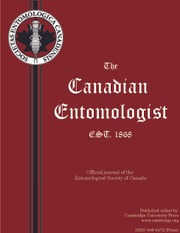Article contents
OVIPOSITION BY GLYPTA FUMIFERANAE (HYMENOPTERA: ICHNEUMONIDAE) IN CHORISTONEURA FUMIFERANA (LEPIDOPTERA: TORTRICIDAE) LARVAE AND THE EFFECT OF HONEY ON THEIR FECUNDITY AND SURVIVAL
Published online by Cambridge University Press: 31 May 2012
Abstract
Females of Glypta fumiferanae (Viereck) (Hymenoptera: Ichneumonidae) lived 8–28 days and oviposited 42–176 eggs if fed honey but lived only 2–5 days and oviposited 4–89 eggs if unfed. Experiments were done under near natural conditions of temperature and humidity (15°–26 °C and 50–80% R.H.). At low host densities fed adults oviposited live eggs daily and unfed adults, 10. Starved adults at low host densities lived about a day longer than those at high host densities indicating that resorption of eggs may occur in this species. General parasite and host density relationships are discussed.
Résumé
Des femelles de Glypta fumiferanae (Viereck) (Hymenoptera : Ichneumonidae) ont vécu 8–28 jours et pondu 42–176 oeufs lorsque nourries de miel, alors qu'elles n'ont vécu que 2–5 jours et pondu que 4–89 oeufs lorsque non-nourries. Des expériences ont été conduites en conditions presque naturelles de température et d'humidité (15°–26 °C et 50–80% R.H.). A des densités d'hôtes faibles, les adultes nourris ont pondu 5 oeufs par jour et les adultes nourris, 10. Les adultes au jeûne à basse densité ont vécu environ un jour de plus que ceux aux densités élevées, indiquant que la résorption des oeufs peut se produire chez cette espèce. La discussion porte sur les relations générales entre les densités du parasite et de l'hôte.
- Type
- Articles
- Information
- Copyright
- Copyright © Entomological Society of Canada 1983
References
- 3
- Cited by




